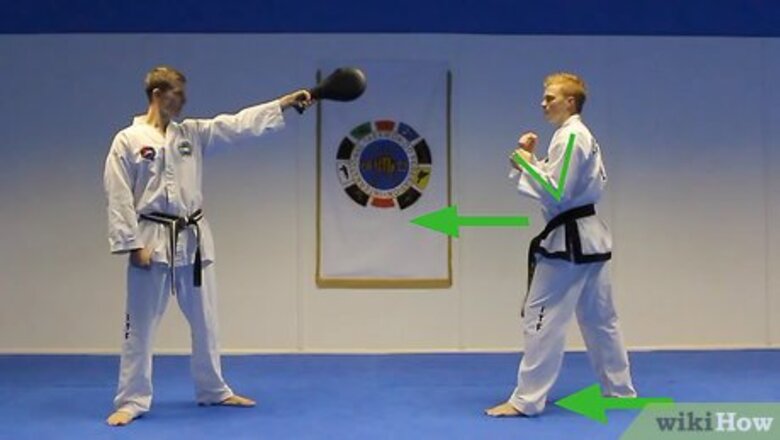
views
Doing a Simple Roundhouse Kick

Get in your guard. In karate and most other forms of martial arts, your "guard" is your basic fighting stance — the way you hold your body in between making your own blows and blocking your opponent's. Your guard makes it easy to strike quickly and powerfully and to react to your opponent's attacks, so it's the ideal place to start before making a roundhouse kick. If you are right handed, to get in your guard, first take a big step forward with your left leg, letting your right foot naturally pivot so it points out to the side. Make two fists and raise your hands so that both arms are bent at the elbow and your forearms are raised slightly. Your left fist should be higher and farther forward than your right, which should be close to your waist. If you're left handed, simply reverse the directions above: step forward with your right foot, drop your left foot back, and so on. Also, when you are in your guard stance, try to protect your face with your fists. This will help you defend against attacks to your face.
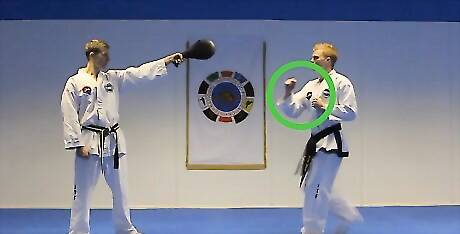
Keep your arms raised, ready to attack and block. If you're practicing roundhouse kicks by yourself, you can take as long as you want to carefully execute your moves. This isn't the case in an actual fight, where letting down your guard momentarily can give your opponent the opening they need to strike. Even if you're not practicing with a partner, get in the habit of keeping your hands up before and after you make your kick. When you do eventually need to use your moves in a fight, having your hands up by default will make you less vulnerable to your opponent's attacks and make it much easier to respond to the attacks they do make with your own.
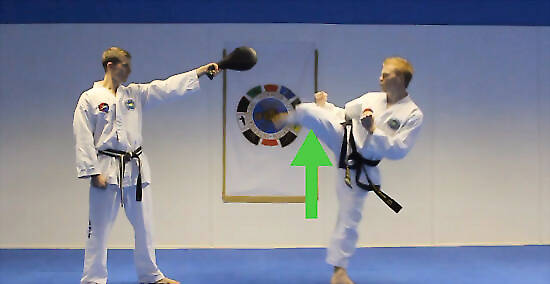
Bring your leg up and to the side. As you raise your rear leg for the kick, bend it back upon itself so that the back of the calf is almost touching the thigh. Bring the bent leg up so that the knee is pointing out to the side. You'll probably need to lean your upper body in the opposite direction for balance. At this point, the muscle in the leg is bunched up and the lower leg is "chambered", ready to deliver a quick, crushing kick. If you haven't done a roundhouse kick before, you may find it tricky to balance on one foot with your leg out to the side. Luckily, there are a number of simple balance-improving exercises (like standing on one foot while waiting in line at the supermarket) that are easy to work into your daily routine.
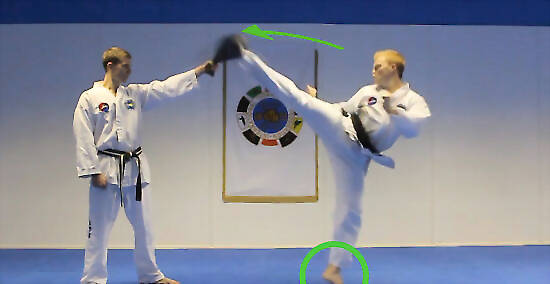
Snap your leg forward, pivoting on your other foot. Pivot on your lower foot, turning your body so that your kicking leg moves toward your target. As you do this, extend the leg in a sudden but smooth motion, "snapping" it forward. You should make contact with the target before your leg is fully extended. In other words, your knee should still be somewhat bent when your leg hits the target — this delivers maximum power. Try to connect with the top of your foot, the ball of your foot, or your instep. Alternatively, you can use your shinbone — this can be especially devastating to your opponent, but can be very painful for you as well.
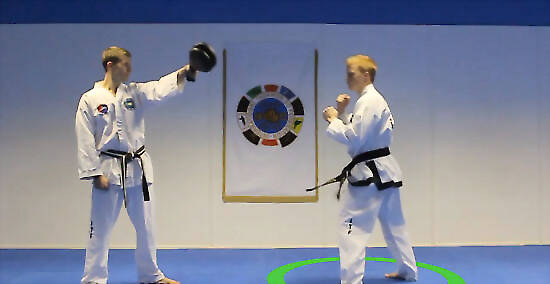
Retract your leg and return to your guard. As you make contact, roll through your target. Let your leg deliver its full power, penetrating a few inches into the body. Quickly retract your leg to its folded position. At this point, you can either "chamber" the leg for another kick or return it to the floor. The less time your foot or leg is in contact with your target's body, the better. Quick, "snappy" kicks transfer lots of energy in the form of damaging shock, while slower kicks use some of their energy to push the target, which is less damaging.
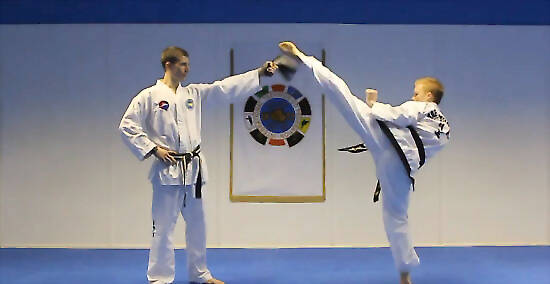
Try using alternate kicking techniques. The basic roundhouse kick detailed above is great for beginners, but it's just one of many possible variations on the move. To increase your versatility during a fight, try learning one or more variations on the basic roundhouse kick. Once mastered, these special moves can give your kick extra speed or power, giving you an edge in a close fight. See the sections below for more detailed explanations of each guard. Use a "side-kick" technique for a quick, direct attack. In a fight between experienced martial artists, speed can be a huge factor in determining the winner. Using this stance can help you release (and recover from) your kick with extra quickness all while advancing on your opponent, allowing you to set the pace of the fight. Use a muay thai kicking technique for power and strength. Sudden, powerful blows can decide entire fights. For situations that call for sudden, forceful blows, using this muay thai kick style, which prioritizes the strength of the kick, can be a wise choice. Use a boxing guard to protect yourself. The basic karate-inspired martial arts guard stance above offers a balanced platform for delivering and blocking blows, but in street fights, bare-knuckle brawls, and self-defense scenarios, it may be hard to use it to block a flurry of punches to the head or body. In these cases, a boxing-inspired guard may make for a more practical defense.

Synchronize your breathing with your kick. Breath control is important for any form of exercise, but in a fight, it's essential — you want to be able to move, block, and kick as quickly as possible without running out of breath or getting the wind knocked out of you, Take deep, steady breaths when your opponent is out of reach. Breathe in as you prepare to make your kick, then exhale forcefully or vocalize (grunt, shout, etc.) each time you kick (or get kicked). Pace yourself as you fight — if you feel yourself running out of energy, back off and take deep breaths to refocus and recoup your stamina. Paying attention to your breathing isn't just for improving your focus and stamina — there's actually scientific evidence to suggest that exhaling or vocalizing during physical exertion (like kicking) can make it possible to exert more force.
Using a "Side-kick" Technique
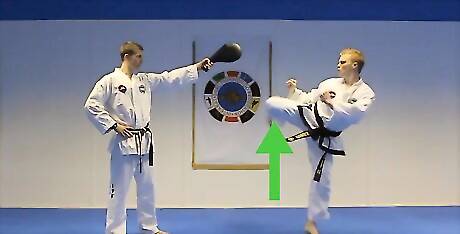
Raise your leg in front of you. The main difference between a basic roundhouse kick and a side kick is that the latter is delivered from in front of the target, rather than from the side. Starting from your basic guard stance, raise your rear leg out in front of you (not out to the side like you would for an ordinary roundhouse kick), bending at the knee as you do so.
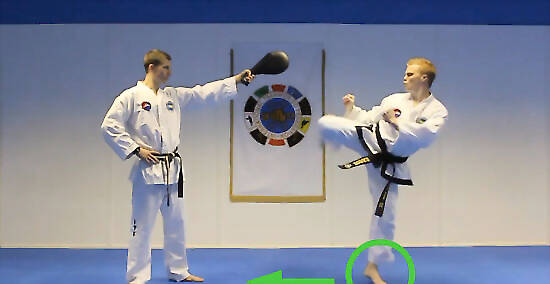
Turn your leg parallel to the floor. Before you deliver your side kick, you want your leg to be parallel with the floor — in other words, the inside of your leg should be facing the floor and your knee should be pointing directly to the side. This requires you to make a few separate movements at once — though they sound complicated, they should actually feel quick and natural after plenty of practice. Do the following: Pivot with your foot on the ground to turn your body so that your bent kicking leg comes in line with your target. Lean away from your kicking leg with your upper body to keep it elevated and maintain your balance. Use your hip muscles to pull your kicking leg up. It should be basically parallel to the floor (or as close as you're able to get it) before you make your kick — the strength of the side kick is in its quick, direct forcefulness.
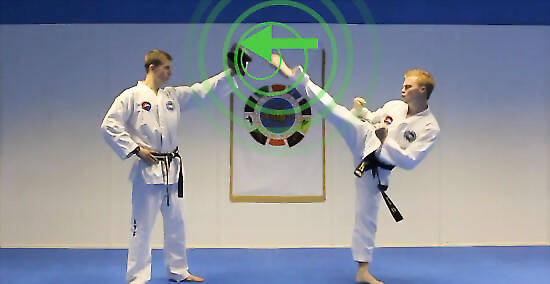
Quickly snap your leg forward. In a single smooth but sudden motion, extend your leg as quickly as you can, making contact with the outer bottom edge of your foot. Ideally, for maximum kicking force, you want your upper body and kicking leg to make a straight line to your target roughly parallel to the floor — this will require you to keep your leg high, lean with your upper body, and turn at the hips as you deliver your kick. As you make your kicking motion, continue to pivot on your standing foot. A full side kick requires about 180 of rotation — your foot will start facing toward your target and end facing away from it as you kick connects.
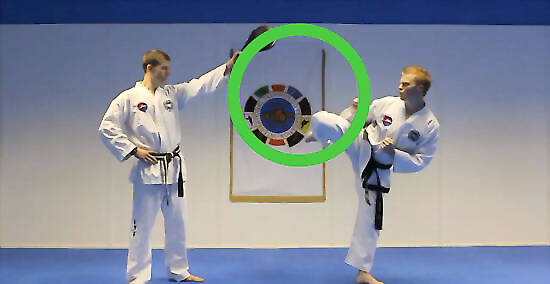
Retract your leg as quickly as possible. When you feel your kick connect firmly, withdraw it immediately (as you would for a normal roundhouse) for the greatest possible striking force. Return to a standing position by pivoting your standing foot back forward and lowering your kicking leg to the ground (or, alternatively, perform more kicks). Not only is the side kick quick and powerful — it's also versatile in terms of striking targets. Depending on how high you're able to raise your leg, it's possible to deliver a side kick anywhere from an opponent's leg or groin to their face. Hip flexibility is essential for raising your leg high enough to hit upper body targets. If you can't get your side kick above an opponent's waist, try starting a regimen of hip stretches to improve your flexibility.
Doing a Mauy Thai Roundhouse Kick
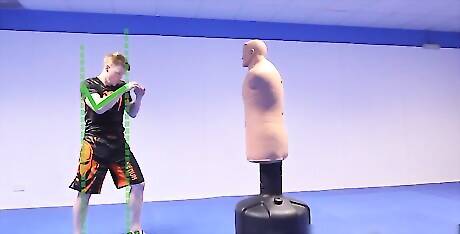
Get into the basic roundhouse guard stance. This powerful roundhouse kick variation uses a different stance than you'd use for an ordinary kick. Take a step forward with your non-kicking foot, then turn your body so your feet are roughly shoulder-width apart. Turn the toes of your rear foot out to the side. Stand up straight with your weight on the balls of your feet and your fists clenched in front of your chest or chin. For muay thai kicks, try to put a little more weight on the back foot than on the front foot. This gives you stability as you react to your opponent's moves and try to set up your kick. When you make your kick, you'll transfer your weight to the other foot for additional power.
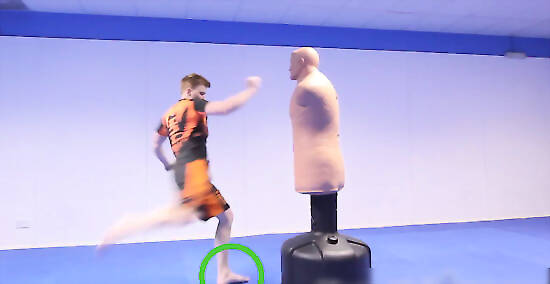
Pivot on your front foot as you swing your rear leg forward. To begin your kick, pivot on the ball of your front foot, turning your toes outwards and your heel towards your opponent. As you do this, raise your leg up and around your body in a smooth arc, putting a bend in your knee as you do so. Try to raise your leg to at least the level of your opponent's waist — your knee should be pointing at or near the center of your opponent's body by the point you start to deliver your kick. At the end of the swing, the hip of your kicking leg should be stacked directly above the hip of your standing leg. Most of the stability and power for the kick will come from this solid pillar of support.
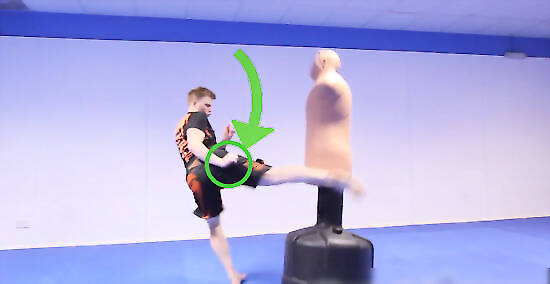
Swing your arm for extra power as your kick. Snap your leg forward as normal, aiming to connect just at or before the point your leg fully extends. As you do this, introduce greater power and speed to your kick by throwing the arm on your kicking side down in a synchronized motion with your kick. Note that this motion leaves you slightly more vulnerable to a counterattack because your swinging arm can't block attacks, so make sure to keep your other hand up to protect your head and face while you make this movement.
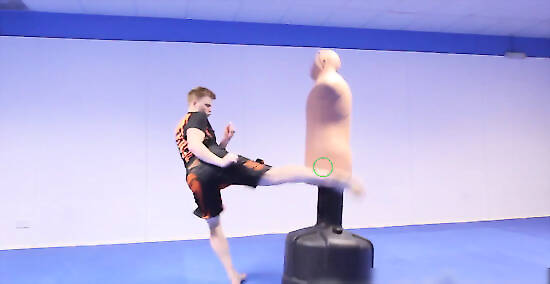
Connect with your opponent. Connect with your opponent's torso or head at your shin or the top of your foot. Try to hit your opponent like a baseball bat, coming in from the side (around his guard) rather than straight on. Once you have made impact, withdraw your leg as quickly as possible for maximum striking power (just as you would for the kicking styles above). As directed above, follow your kick up with another kick or return to your starting position, pivoting your standing foot back around as you do so. Whichever option you use, be sure to return your kicking arm back to its guard position as quickly as possible to protect against a counterattack.
Using a Boxing Guard
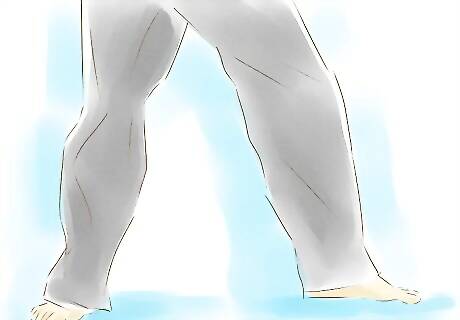
Stay light on your feet. In the words of Muhammad Ali, one of the greatest boxers of all time, "Float like a butterfly, sting like a bee." For boxers, mobility is key for reacting to an opponent's moves, dodging punches, and setting up combinations. Using this boxing-inspired guard stance, it can be easier to block and dodge an opponent's blows while setting up your roundhouse kick. To start, rather than using the one-foot-back-one-foot-forward guard stance described above, you'll want to stay mobile, constantly taking short, choppy steps. This makes it easier to dodge your opponent's blows and "dance" out of their reach when you're recovering between blows.

Keep your hands up near your head. Bend your elbows and raise your hands so that they are several inches from your chin (ideally with fists clenched, though this isn't necessarily essential). Keep your elbows tucked against your body, but don't tense your upper body — stay loose and relaxed.Your forearms should form a "cage" around the bottom of your head, protecting it from blows from the front. If your opponent tries to punch or kick you in the head, you can bring your arms together for more protection. This guard stance leaves your torso and midsection relatively unprotected — you can counter this somewhat by staying low and keeping your shoulders forward. You can also block body blows by dropping your guard low with your forearms crossed, though this will leave your head open.

Bring your leg into the "chambered" position. Once you've gotten the hang of the boxing guard stance, try performing a few kicks (you can use a basic roundhouse kick, a side kick, or a muay thai style kick — whichever you find easiest). Bring your kicking leg out to the side or in front of you with the knee bent all the way. As you do this, pivot on your standing foot and lean your upper body for balance until your leg is sufficiently raised. As you do this, don't forget to keep your guard up near your head — a smart opponent may use your set-up time to get in a free punch. Though the boxing guard can be more practical for protecting yourself in a fight, staying balanced can be a little trickier with this stance, so be sure to practice plenty before you try performing a roundhouse kick in an actual self-defense scenario.

Kick as normal. Snap your leg out out, extending it as quickly as possible. Make contact with your target, then withdraw your kick as quickly possible for maximum striking force. Follow up with another kick or drop your leg to the floor and start taking quick, light steps with your guard up, ready to react to your opponent.



















Comments
0 comment